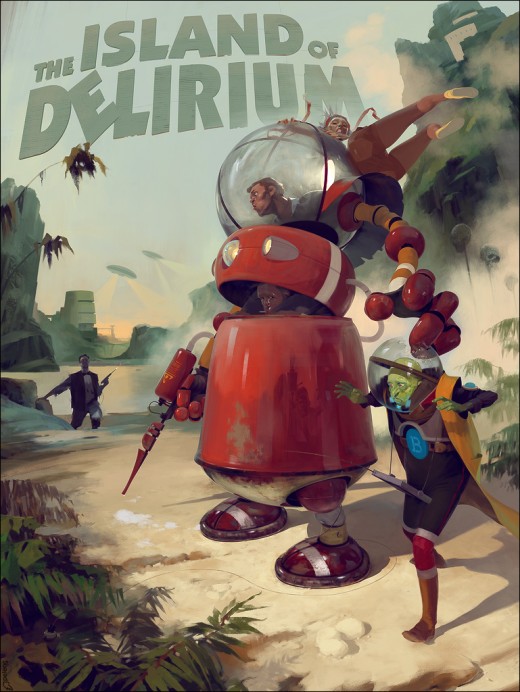September 20, 2013 - Comments Off on Humans stop light for a minute in a quest for more data storage
All Posts in future
August 6, 2012 - Comments Off on Martian Magnificence
Martian Magnificence
Good news everyone! We've landed on Mars! Again! Think about that. We shot a sizable and expensive package through outer space and hit a target crater on a planet millions of miles away--multiple times. What could we accomplish if all the world's nations worked together, Sagan willing. Mars has been the seed of many interesting ideas over centuries. The need to explain its retrograde, or apparent backwards, motion in the night sky was one of the greatest observational pieces of evidence against geocentric models of our solar system. On the other, less scientific, hand the signs of dried out watery canals discovered in the 19th century lead to the idea of alien societies living on the once water-filled planet composed of resident martians, a word now synonymous with aliens at large. Thus the idea of life on Mars was launched the popular imagination and has since continued to be an unearthly inspiration.
Nothing epitomizes our space age fascination with the void more than the pulp era. Sergey Kolesov adds a sharp modern edge to the classic space opera style within his greater portfolio of stunning work. His work uses depth and perspective to great effect, creating epic scenes within each still image. This is strongly complimented by his skill in color and composition which leave the viewer feeling as if they've just gained a peak into a magical world unto its own.
Going to Mars would never be possible if it weren't for the corporations getting us there. Weyland megacorp, last seen undermining poor Sigourney Weaver, has an exquisite site that any fictional 23rd century company could be proud of. Clearly the marketing department for this film did not suffer for lack of budget, disappointing as the actual product was. Though this page is in essence a glorified index of their marketing strategy, the strong design stands out, crappy mini-games aside, as a prominent showcase of the capabilities of HTML5.
There are some obvious choices for Mars in video form but I rather prefer this short animation which depicts how I imagine NASA is currently corresponding with their newly landed probe. And though I can't post it here, I'd like to give an honorable mention to Insterstella 5555, the album length music video for Daft Punk's discovery. This animation in an incredible tale of alien abduction with a twist, all in anime form. Please seek it out especially if you're at all fond of Daft Punk (the low resolution versions online just don't hold up).
The Sketching Mechanism is a series of weekly posts, published on Mondays, containing the artistic musings of Mobile Designer/Developer Ben Chirlin from our Monday morning meeting at the NY Creative Bunker as well as his inspiring artistic finds of the week.
July 13, 2011 - Comments Off on The Social Mechanism – 7/13/11
The Social Mechanism – 7/13/11
On July 12, media sources were reporting that Google+ -- Google's latest (and potentially most successful) foray into social networking, launched in a limited-release on June 28 -- had already, or would soon have reached 10 million users. Now, that's not much to crow about if you compare it to Facebook's 750 million, or even the (recently sold-for-scrap) MySpace's 37 million remaining accounts. But when you consider that Google+ is still an invite-only party that has been online just two weeks, and that those invites were out-of-service for much of that time -- 10 million starts to sound a little more impressive.
Of course early-adoption is no guarantee of success, and it's obviously too early say whether or not Google+ will be able to attract users beyond the first flush of novelty -- it certainly wouldn't be the first time Google laid an egg in the social networking realm (*cough*Buzz*cough*), but based on what I've seen and experienced so far, I will say that Google+ has legs, and I'd be willing to bet that, while I wouldn't call it a "Facebook killer," exactly, it has the potential to become even more integrated into our daily lives than Zuckerberg's oeuvre has. Here's why:
- It's not Facebook. Or as someone in my Google+ circles said, "I'm trying to escape Facebook!" Perhaps a backlash is inevitable anytime something goes from niche-popularity to total ubiquity and market-dominance, but Facebook detractors have no lack of reasons to welcome a new player onto the field. From concerns about personal privacy to frustrations with the graphical interface, Facebook has pissed off a lot of users, and Google will doubtless benefit simply by being an alternative that works. Additionally, Google has been paying attention to people's complaints, particularly as it concerns privacy, and they seem to have learned from others' mistakes. The Google+ Privacy Policy is shorter and an easier read than Facebook's, and the privacy settings on Google+ are (for now, at least) more customizable than Facebook's, which by itself could be the deciding factor for a lot of people.
- You're already using it. Okay, so maybe you haven't gotten an invite into Google+ yet, but it's fairly likely that you've utilized one of Google's several other web products, such as Gmail, Google Docs, Google Calendar, Blogger (re-branded as Google Blogs), or Picassa (now Google Photos). Even if you haven't taken advantage of any of the offerings in the Google "cloud", chances are pretty slim that you've spent any time on the internet in the last 10 years without availing yourself of the web's most popular search engine.So Google isn't some new kid on the block -- it's a source we're all familiar with, and that a lot of us use often in our day-to-day routines, for work and pleasure. Google+ interacts with all of its sibling programs and products, with notifications and the ability to share things among your "circles" in the upper-right-hand corner of any Google site. How much easier is it, for those of us who are already using Google sites and products for our workflow, to check our notifications, or write a status update from the very page we're already working on?
- Granular control of your communications. Google+ gives users more control of the messages they send into the ether -- not only by allowing people to use "circles" to organize their contacts, but but also by allowing users to edit and remove content they've added to their streams, or to "mute" conversations they're no longer interested in. It seems small, but how many times have you wished you could go back and edit that typo out of your status update? Or wished you didn't have to be notified every time someone else leaves a comment on your sister's new profile photo?
- Huddles and Hangouts. I haven't had the chance to use the Huddles feature yet (this is a mobile-only feature that hasn't been released on iPhone yet -- more on that below), so I'll reserve comment except to say that the idea of a non-SMS chat for mobile phones sounds good, and will no doubt be exceptionally popular with the teen and tween populations currently forced to send texts one-at-a-time to their friends.Hangouts are a bit more exciting -- think of them as temporary, virtual living rooms (or cafes, or pubs, or screening rooms, what-have-you...) where you and your circles can convene, chat, view media together, and generally, well, hang out. This is more than just video conferencing. I haven't used it much, but I can see Hangouts being useful in several different arenas, from professional conferencing to long-distance family reunions. As another of my Google+ contacts put it, "I just really like being able to share a real experience (even if virtually) with people I can't see because of geography."
Things are not all sunshine and rainbows, however. As with any new product, there is some room for improvement, and some areas where Google has some kinks to work out. Personally speaking, my only real complaint is that they launched Google+ without native iPhone or iPad apps (yes, I understand they're giving their own Android apps a leg up, but no iPhone app out of the gate? Really?). Other users I've communicated with offered such wish-list improvements as better integration among the Google sites (being able to access Google calendar without having to open a new tab, for example) and a more consistent, less "cutesy" naming convention for the various functions and features. I have heard a bit of grumbling online that the "Sparks" feature (a kind of customizable recommendation engine) is not quite ready for prime-time (to be fair, I've also seen this called the most underrated of Google+ features), and while the Huddles feature is a great addition to the mobile platform, there is no analog for regular web users (we're stuck with the now old-fashioned feeling Google Talk). But that's why Google is calling this a project instead of a product -- it is still a work in progress, and will continue to evolve as it continues to gain a user-base (my Google+ circles have been growing steadily since I signed on nearly two weeks ago), and communities form.
Here are some useful links for those of you not yet familiar with Google+, and those of us hoping to learn more:
- Google+: First Impressions
http://mashable.com/2011/06/28/google-plus-review/ - 10 Things You Never Knew Were Possible On Google+
http://www.businessinsider.com/google-plus-tips-2011-7#ixzz1RzvwY8ht - The One Google Plus Feature Facebook Should Fear
http://www.allfacebook.com/the-one-google-plus-feature-facebook-should-fear-2011-06 - Google Plus vs. Facebook on privacy: Plus ahead on points - for now
http://www.wired.co.uk/news/archive/2011-06/29/google-facebook-privacy - Google+ Privacy: Five settings you need to know
http://www.macworld.com/article/160970/2011/07/googleplus_privacy.html
Published by: saraweythman in The Thinking Mechanism
Tags: connect, future, google, Social Networking



